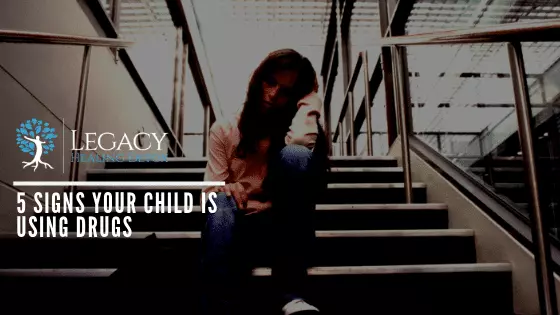
5 Signs Your Child is Using Drugs
Legacy Healing Center Blog
Children can be a constant source of worry for any parent. It is terrifying to watch children grow up so quickly, but it is even more frightening to think about the possibility of your child using drugs. Regardless of any preventative measures you have taken as a parent, there is always the chance of your child experimenting with drugs. Substance abuse prevention methods work well for some families, but for others, it all comes down to trial and error.
The adolescent brain is continually changing, and using drugs during this time can affect decision making and cognitive functions. Adolescents and teenagers who abuse drugs are at higher risk of developing an addiction later in life. Therefore, it is important to watch for signs that your child is using drugs.
There is hope!
Download our free Addiction Recovery Guide for Families and learn about addiction, how it’s treated, and how to heal for a more meaningful life.
1. Isolating, lying, and secretive behaviors
If your child is normally very extroverted and talkative, but you notice that they have begun isolating from friends or family, spending a lot of time in their room, and avoiding eye contact, it may be a sign that your child is using drugs.
In addition to isolating, your child may begin locking doors and lying about their whereabouts. They may begin sneaking out at night, disappearing for extended periods of time, and stay in their room with no explanation of what they were doing. If your child becomes nervous or angry when you confront them about their isolation and secrecy, it may be a sign that your child is using drugs.
2. Changes in appearance and personal hygiene
Physical changes are subtle in the beginning and progress over time. The changes in appearance and hygiene will vary depending on which substance is being abused, but some signs you can look for include:
- Constricted or dilated pupils
- Bloodshot or glossy eyes
- Flushed cheeks
- Pale or clammy skin
- Tremors or shakes
- Rapid weight loss
- Scars on face or arms from picking
- Bruising or track marks on arms
- Lack of hygiene
- Disheveled hair, clothing, or overall appearance
3. Changing habits, performance, and environment
If your child is using drugs, they may begin to stray away from their usual activities. Whether it is sports, music, or art, they may begin to show a lack of interest in their previous hobbies. As drug use becomes more serious, adolescents will often begin to hang out with a new group of friends or at new places. People who are using drugs will typically associate themselves with like-minded people.
Has your child’s school performance been decreasing lately? Have they had some unexplained absences or behavioral issues at school? If so, this could be a sign that your child is using drugs. Drugs can affect a child’s ability to study and perform academically as well as make them lose interest in their school work. They may also be skipping class, arriving at school late, or causing behavioral concerns in the classroom.
4. Changes in appearance and personal hygiene
If you observe that your child has begun behaving differently, it is time to take a closer look to see if they are exhibiting any of the behavioral signs associated with drug abuse. Behavioral changes are one of the first things many parents notice when their child is using drugs.
Some behavioral changes that are associated with adolescent substance abuse include:
- Arguing with siblings and family members
- Lashing out in anger
- Flushed cheeks
- Violating curfew
- Hanging out with a new group of friends
- Reckless driving
- Changes in appetite
- Manic behavior
- Irritability or restlessness
- Mood swings
- Depression
- Slow or fast speech
- Poor coordination
- Unusual sleeping patterns
- Stealing money or excessive spending of money
You may also notice missing prescription pills or bottles from your medicine cabinet or notice that jewelry or money has begun disappearing. If so, your child may be abusing old prescription medication or selling the families valuables to get drugs.
5. Drug paraphernalia in the home
Many think of things like syringes and pipes when they think of drug paraphernalia. However, there are many more subtle forms of drug paraphernalia that you may overlook. Some examples of drug paraphernalia to watch out for in your child’s room and possessions include:
- Straws
- Lighters
- Bent spoons
- Credit cards with residue on them
- Razor blades
- Pieces of cotton
- Tin foil
- Eye drops
- Prescription pill bottles
- Small, clear capsules
- Small plastic baggies
What to Do About Your Child Using Drugs
While many of these signs of drug use can also be associated with the multitude of changes that adolescents experience, noticing several of these signs indicate that your child may be using drugs. In the end, you know your child best and you know what is normal for them and what is worrisome.
Although it is unreasonable to expect teens to completely abstain from drugs due to curiosity and peer pressure, it is important to consider the long term effects of substance abuse. You should speak to your child directly and openly about their drug use, set your expectations, and get professional help from drug rehab or addiction specialist if the situation is out of control.
